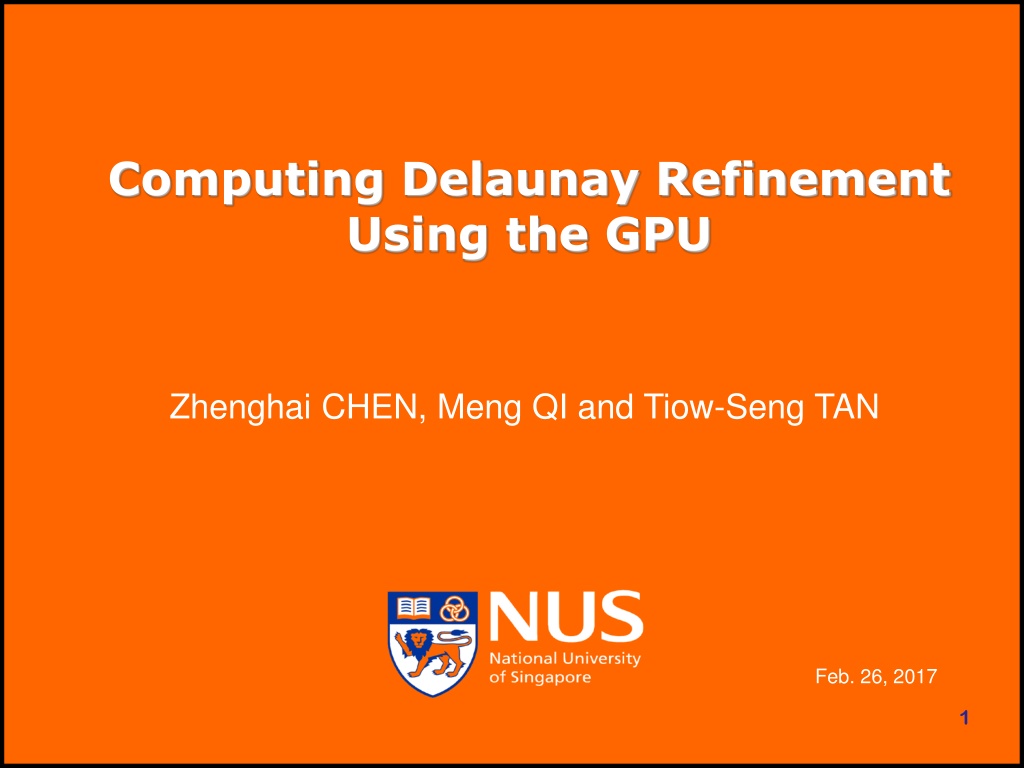GPU-Accelerated Delaunay Refinement: Efficient Triangulation Algorithm
This study presents a novel approach for computing Delaunay refinement using GPU acceleration. The algorithm aims to generate a constrained Delaunay triangulation from a planar straight line graph efficiently, with improvements in termination handling and Steiner point management. By leveraging GPU processing, the proposed method achieves significantly faster performance compared to traditional CPU implementations while maintaining similar output quality. The research builds upon existing sequential algorithms and extends GPU-based refinement techniques to enhance computational speed and accuracy.
- GPU acceleration
- Delaunay refinement
- Triangulation algorithm
- Planar straight line graph
- Steiner points
Uploaded on Sep 08, 2024 | 0 Views
Download Presentation

Please find below an Image/Link to download the presentation.
The content on the website is provided AS IS for your information and personal use only. It may not be sold, licensed, or shared on other websites without obtaining consent from the author. Download presentation by click this link. If you encounter any issues during the download, it is possible that the publisher has removed the file from their server.
E N D
Presentation Transcript
Computing Delaunay Refinement Using the GPU Zhenghai CHEN, Meng QI and Tiow-Seng TAN Feb. 26, 2017 1
Outline Introduction Literature Review Our Algorithm: gQM Proof of Termination Experiment Results 2
Introduction Delaunay refinement problem: Input: a planar straight line graph (PSLG) and an angle ? Output: a constrained Delaunay triangulation (CDT) with no angles smaller than ? (by adding Steiner vertices where needed) Two Issues Process has to terminate Manage number of Steiner points 3
Introduction - contributions The first GPU Delaunay refinement algorithm with PSLG as input. A few times to an order of magnitude faster than the best CPU implementation, Triangle [Shewchuk 96]. Output by our algorithm is of a similar size to that by Triangle. 4
Literature Review Two famous sequential algorithms Ruppert s (1995) Chew s (1993) Two software Triangle (CPU, by Shewchuk, 1996) Galois (GPU, by Nasre, 2013) Current work extends on our previous ones: gDel2D I3D 2012 Flipflop I3D 2013 5
Literature Review Ruppert s algorithm (1995) : two main steps 1. Split encroached (input) segments. a p a p a p d c c b b b 2. Split bad triangles. Insert and reject points. b a a b 6 Reject encroaching point Split bad triangle t
Literature Review Chew s algorithm (1993) : two main steps 1. Split bad triangles. Insert and reject points. 2. Split segments and remove redundant points. a a b b redundant points indicated as hollow c is circumcenter of bad triangle t
Literature Review Triangle (CPU, by Shewchuk, 1996) 1. The fastest CPU Delaunay mesh generator. 2. Unify Ruppert sand Chew s to a certain extent. a b Diametral len for Chew s mode Diametral disk for Ruppert s mode Galois (GPU, by Nasre, 2013) Handle point set as input 8
Our Algorithm: gQM gQM (GPU) and Triangle (CPU) differ in three aspects besides parallel vs sequential: Unify Ruppert's and Chew's fully Adapt neatly FlipFlop algorithm [I3D 2013] to discover encroachment and to remove redundant Steiner points Before insertion, selective in inserting Steiner points to avoid roll back 9
Our Algorithm: gQM gQM (GPU) Triangle (CPU) 1. Split encroached segments and remove redundant points 1. Split encroached segments. Under Chew's mode, remove redundant points 2. Split bad triangles with independent points 2. Split bad triangles. Insert circumcenters and reject encroaching points The only difference of two modes: Ruppert s: Diametral disk Chew s: Diametral len 10
Our Algorithm: gQM gQM Triangle 1. Split encroached segments and remove redundant points 1. Split encroached segments. Under Chew's mode, remove redundant points a a a b b b 11
Our Algorithm: gQM gQM Triangle 1. Split encroached segments and remove redundant points 1. Split encroached segments. Under Chew's mode, remove redundant points a b 12
Our Algorithm: gQM gQM Triangle 1. Split encroached segments and remove redundant points 1. Split encroached segments. Under Chew's mode, remove redundant points a b 13
Our Algorithm: gQM gQM Triangle 2. Split bad triangles with independent points 2. Split bad triangles. Insert circumcenters and reject encroaching points b a Filter points: a Point location Compute Delaunay independent points b Ruppert s Chew s 14
Our Algorithm: gQM gQM Triangle 2. Split bad triangles with independent points 2. Split bad triangles. Insert circumcenters and reject encroaching points Always insert these points regardless whether encroaching or not FlipFlop: to maintain CDT and mark encroached segments a a b b 15
Our Algorithm: gQM Flipflop [Gao: I3D2013] Flip to Delaunay; flop to remove point Maintain CDT, remove redundant points and update encroachment situation using parallel flipping 16
Proof of Termination Never introduce an edge shorter than some constant (feature size) Every iteration inserts at least one point Finite underlying space of the triangulation Terminate No more bad triangles 17
Experiment Results Intel i7-6700 3.4GHz CPU and GTX980 Ti graphics card Generate random PSLGs on the uniform, Gaussian, disk and circle distributions The number of points ranges from 50,000 to 100,000 Number of segments ranges from 10 to 50% of number of points Minimum allowable angle ? = 15 , 20 , 25 18
Experiment Results Output samples of synthetic data Input segments in red Steiner points in blue points lie in the ring formed by two circles all points lie inside a disk 19
Experiment Results The speedup of gQM over Triangle for 100K input points and 10K to 50K input segments Ruppert s Chew s 20
Experiment Results The percentage of extra points in the output mesh of gQM compared to Triangle with 100K input points and 10K to 50K segments. Ruppert s Chew s 21
Experiment Results non-synthetic data: 22
Project Website http://www.comp.nus.edu.sg/~tants/gqm.html Q & A 23



































